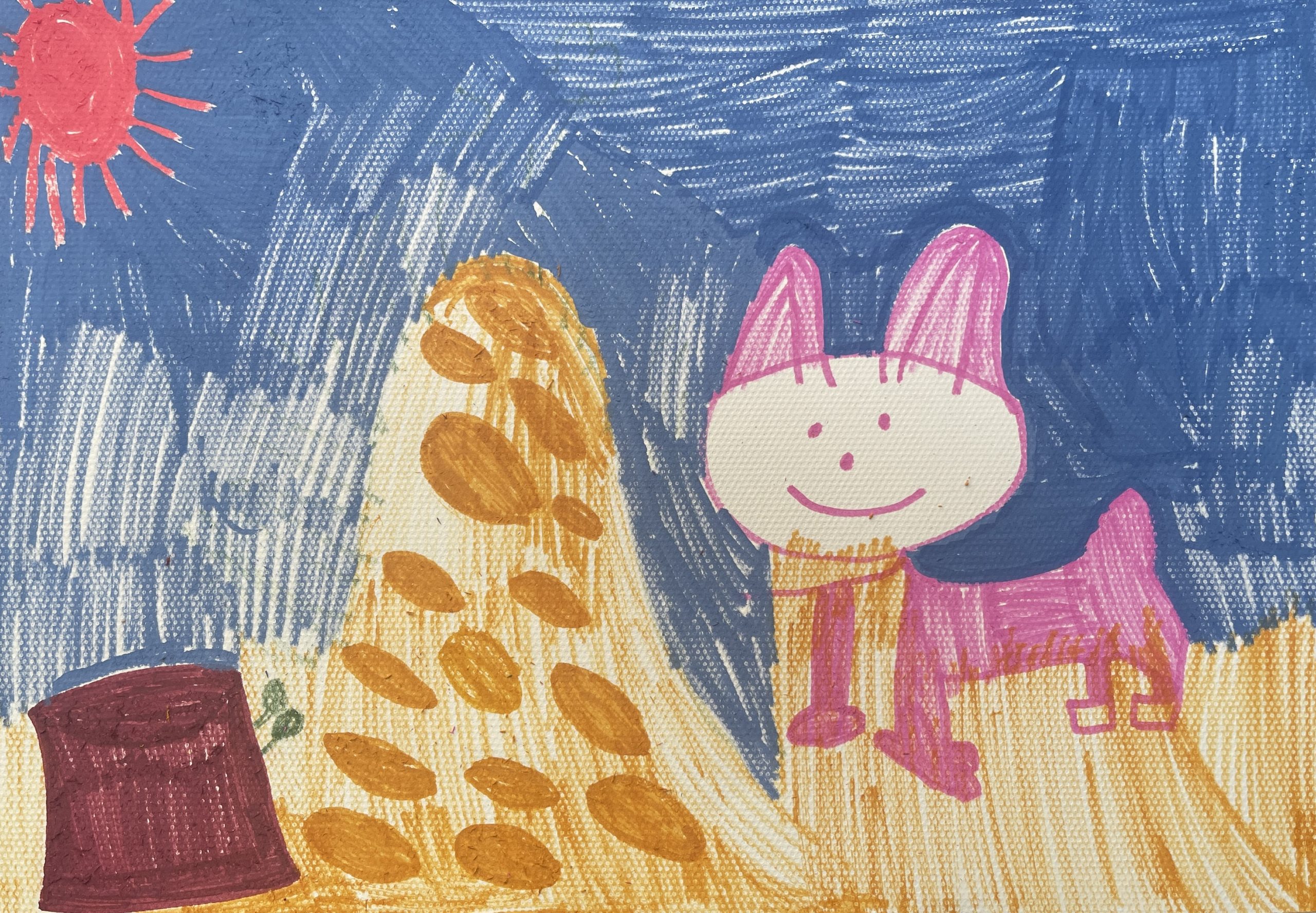ArtTherapy and Art Education: Overlapping
Functions
“Art Therapists Frequently
Work With Children Whose Ego-Functions and Sense of Self Have Been Insufficiently Supported in Infancy and Early Childhood. Among Them Are Children Who Have Been Grossly Neglected, Those For Whom Support was Interrupted as Soon as They Ceased to be Appealing Babies and Became Troublesome Toddlers, and Others Whose Elders Were Too Impulse-Ridden to be Able to Support Their Children’s Growth Consistently.
psychotherapy. However, there are important distinctions between these adjacent disciplines.
In all realms pertaining to art and art materials the art therapist’s skills surpass those of psychotherapists who use art materials only inciden-tally. Conversely, art therapists, even achievements, sometimes must com- though they develop considerable promise by diluting or perverting the sagacity in the verbal interchange creative process; he may become which naturally occurs in the course product-oriented against his better of art therapy, cannot be expected to judgment. On the other hand, it is true match the psychotherapist’s capacity that art therapy is distinguished from to perceive the hidden meaning of art education by a much lower rate of verbal communication or his knowl-finished work.
edge about how to use words The art therapist who works with therapeutically. extremely handicapped children must Matters are, however, even h. re vastly more often than the art teacher complicated. We cannot simply be contented with fostering processes equate the art produced in art therapy that do not culminate in any lasting with the words used in adult product. At times all thought of psychotherapy, or with the play and achieving finished paintings or talk that replace purely verbal inter-sculptures may have to be abandoned change in child therapy. Communica-while children endlessly experiment tion in psychotherapy is typically fluid with art materials, vent their anger on and unformed, and attention is fo-them, or desert their work before it is cused in the main on content. While finished.
art therapists encourage unconven-Furthermore, disturbed children’s tional form as well as content in art, preoccupations with their inner con- they are nevertheless intent on foster-flicts frequently make them inaccessi- ing artistic eloquence. For the depth ble to conventional educative and verity of the experience in art methods. Established ways of therapy are in many ways bound up stimulating the focusing perception with its formal qualities. Above all,ence. To quote Susanne Langer: “Theprimary function of art is to objectifyfeeling so that we can contemplateand understand it. It is the formulationof so-called “inward experience, the”inner life, that is impossible toachieve by discursive thought, be-cause its forms are incommensurablewith the forms of language….But how can we stimulate interestin art in the disturbed and handi-capped children in our care? Arttherapists frequently work with chil.dren whose ego-functions and senseof self have been insufficiently sup-ported in infancy and early childhoodAmong them are children who havebeen grossly neglected, those forwhom support was interrupted assoon as they ceased to be appealingbabies and became troublesometoddlers, and others whose elderswere too impulse-ridden to be able tosupport their children’s growth con-sistently. Identification with dutifulbut joyless parents can also deprivechildren of the inner contentment thashould accompany the sustained effort of which they are capable.Ordinarily educative methods areusually ineffective with such childrenMany of them have not learned tovalue any skills or talents they maypossess and are therefore not pre-pared to identify with us on the basisof admiration for our skills or otherenviable qualities. Even though manyof them clamor vociferously for praiseor material rewards for any token efforts they consent to make. rewardsor praise fail to spur them on. Neithecan we capitalize on the children’scompetitive spirit to engender en-thusiasm.When selfesteem is abysmally low,competition does not act asa stimulus; it leads to despair. Wemust try to play down any competition for our attention and seryices as itarises. To stimulate productive work.we must begin at the beginning: wemust celebrate any steps in ego functioning the child may make, much as amother celebrates any signs of goal.directed behavior in her baby. Suchan attitude may seem to infantilize thechildren, but actually we are addres-sing ourselves to the infantile.emo.tional level on which they are indeedfunctioning, cutting through the de-fiant or manipulative front whichhelps such children survive in theworld. But we must reioice only inreal achievements, however minutethey may be-insincerity inevitablydefeats our purpose.The mutual pleasure that grows upbetween adults who love their fieldand children who are inspired by andidentify with their mentor’s en-thusiasm is so common that it mayseem supertluous to make an issue ofit. This shared pleasure is neverthe-less only one of many different waysin which adults strive to mobilize chil.dren’s energies for contructive workWe must distinguish it from simplepraise and from material rewards. Atbest the latter confirm support that isalso being conveyed in more subtleways; at worst they are potentiallyharmful substitutes for the expressionof genuine appreciation on the adult’spart. Nothing good can come from anadult’s dutiful effort to lavish extrava-gant praise on some childish effort inwhich he is unable to take any realpleasure or interest. As for materialrewards, it is wise to resort to themmainly as an incentive for performingunpleasant duties or dull routine tasksbut to refrain from using them where itcan be reasonably expected that thework itself will be gratifying. Rewardsand punishments are invaluable forenforcing the rules and regulationsneeded in daily life. but they have nopower to inspire emotional invest-.ment, When children are conditionedentirely by systems of reward andpunishment-however ingeniouslydevised-they are unlikely to experi-ence inner commitment to any task orthe resulting satisfaction in work welldone.In this spirit we will note any newlycreated color, any increase in thework’s organization, any creative departure from empty stereotypes-inshort, any real improvement. Whenwe rejoice in improved behavior, wewill tie our comments to the child’smain purpose. For example. we mightsay “It is great that you did not wasteyour art session fighting but used yourtime to paint a good picture,’’or “l am glad that you managed to wait patiently and did not tear up your goocwork until I had time to help you,and so on.Naturally we will also show ourpleasure in improvements in other aspects of life-in the children’s moodhealth,academic work, and otherareas. However. we will not jeopardize the dienity of the productiveprocess by conveying the idea that weare using art as a means to an end andonly want the children to produce because we hope that this will somehowimprove their condition or their be.havior. Lack of genuine respect forand disinterested pleasure in chil.dren’s ego-functions is a major causeof emotional illness and must not beperpetuated in the name of therapy.We are more likely to be rewarded byimprovement in both art and life if wevalue children’s art for its own sake.
In conclusion, what links art therapy to art education is understanding of the productive processand genuine respect for the productswhich are the result of children’s cre.ative efforts.
Edith Kramer, ATR, HLM, is adjunctprofessor ofart therapy, New YorkUniversity, New York, New York.
This article constitutes a condensed andmodified version of material presented inChildhood and Art Therapy by EdithKramerin collaboration with Laurie Wilson,published by Schocken Books.inc.. 1979
Edith Kramer 深入探讨了艺术治疗和艺术教育之间的相似之处和相互联系。她强调,尽管两者在实践中有所区别,但它们共同的核心在于理解和尊重儿童的创造性过程及其成果。艺术治疗与艺术教育的共同点:两者都关注创造性过程,而不是仅仅以产品为导向。Kramer批评了将艺术教育简化为产品导向的观点,认为真正的艺术产品应是创造性过程的结果。
艺术治疗的特殊挑战:艺术治疗师常与在婴儿期和早期童年自我功能和自我感觉未得到充分支持的儿童工作,包括被严重忽视的儿童和那些因长辈情绪不稳定而缺乏持续支持的儿童。
艺术教育的误解:面对家长或行政要求的易于展示的成就,艺术教育者有时不得不妥协,从而变得以产品为导向,即便这违背了他们的专业判断。
艺术治疗的过程导向:与艺术教育相比,艺术治疗更少关注完成作品的数量,更多关注创造性活动的过程,尤其是对于严重残疾的儿童。
艺术治疗与心理治疗的区别:艺术治疗师在艺术和艺术材料方面的技能超越了偶尔使用艺术材料的心理治疗师。然而,艺术治疗师在言语交流方面的洞察力可能不如心理治疗师。
艺术表达的形式与内容:艺术治疗中,艺术作品的形式和内容同样重要,它们共同构成了治疗中的沟通方式,激发儿童的艺术兴趣:对于自我价值感低的儿童,传统的教育方法可能无效。艺术治疗师需要通过庆祝儿童自我功能的每一个进步来激发他们的兴趣。
真诚地欣赏儿童的艺术:艺术治疗师和教育者应该真诚和内容同样重要,它们共同构成了治疗中的沟通方式。激发儿童的艺术兴趣:对于自我价值感低的儿童,传统的教育方法可能无效。艺术治疗师需要通过庆祝儿童自我功能的每一个进步来激发他们的兴趣。
真诚地欣赏儿童的艺术:艺术治疗师和教育者应该真诚地欣赏儿童的艺术作品,而不是将艺术作为达到其他目的的手段。
全球艺术治疗与艺术教育重看发展的意义讨论:
艺术治疗和艺术教育的重鲁发展在全球范围内具有重要意义。首先,这种重叠强调了创造性过程在个人发展中的核心作用,这对于培养儿童的自我表达和情感调节能力至关重要。
其次,通过艺术治疗和艺术教育的结合,可以更全面地满足儿童的发展需求。艺术治疗提供了一种非言语的表达方式,这对于语言发展尚未成熟的儿童尤其重要。同时,艺术教育通过鼓励探索和创新,促进儿童的认知发展和社交技能。



